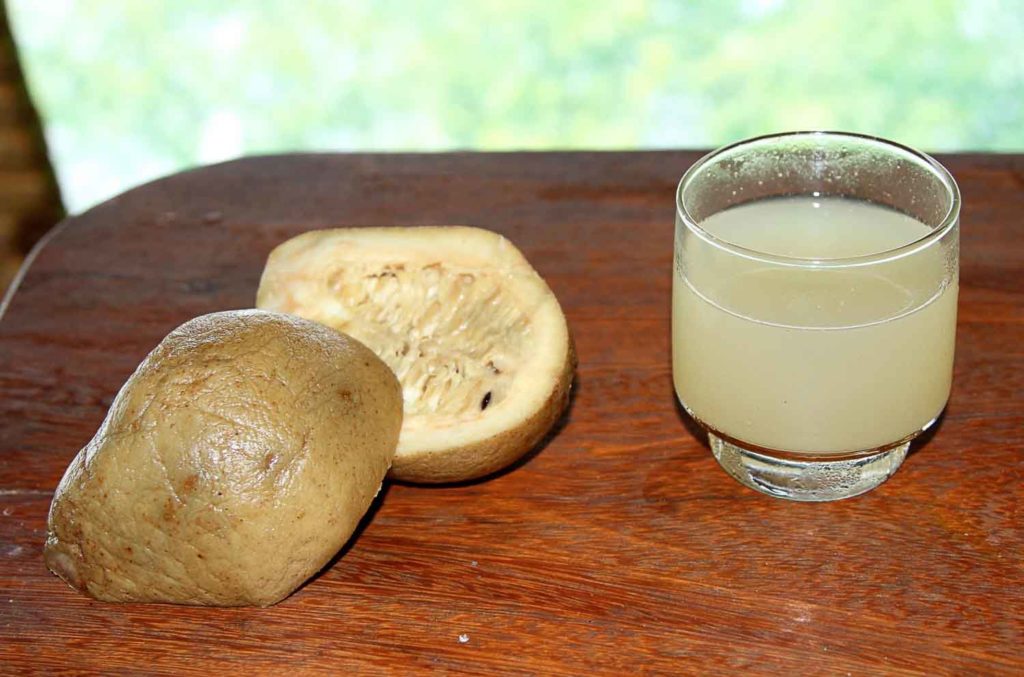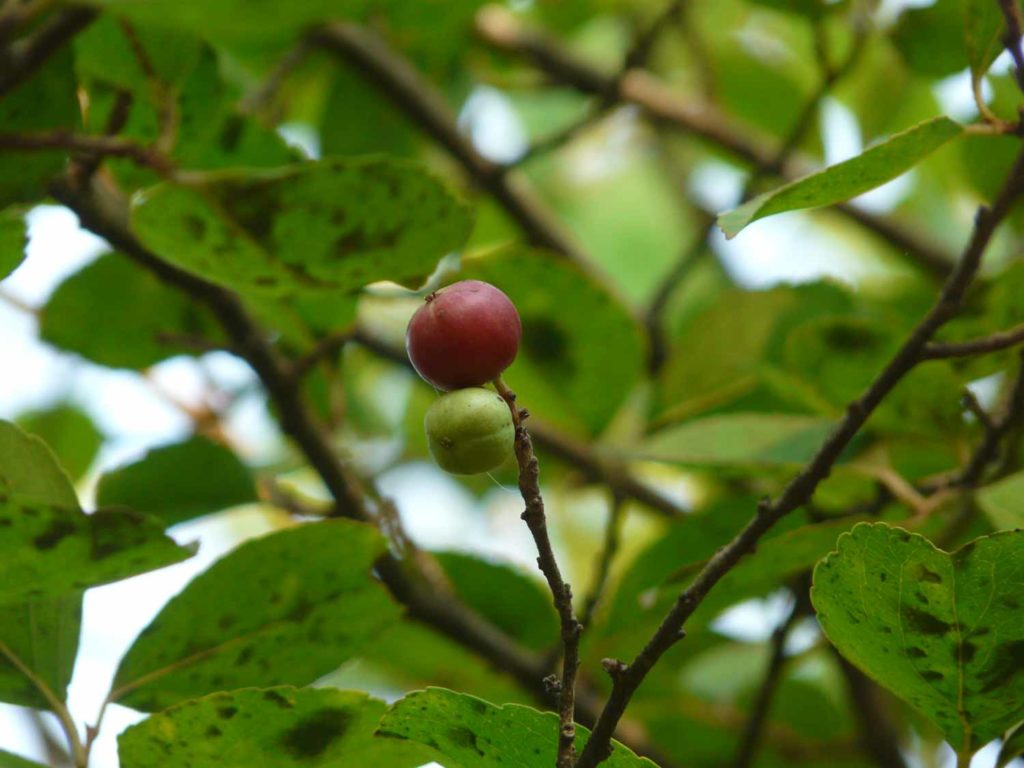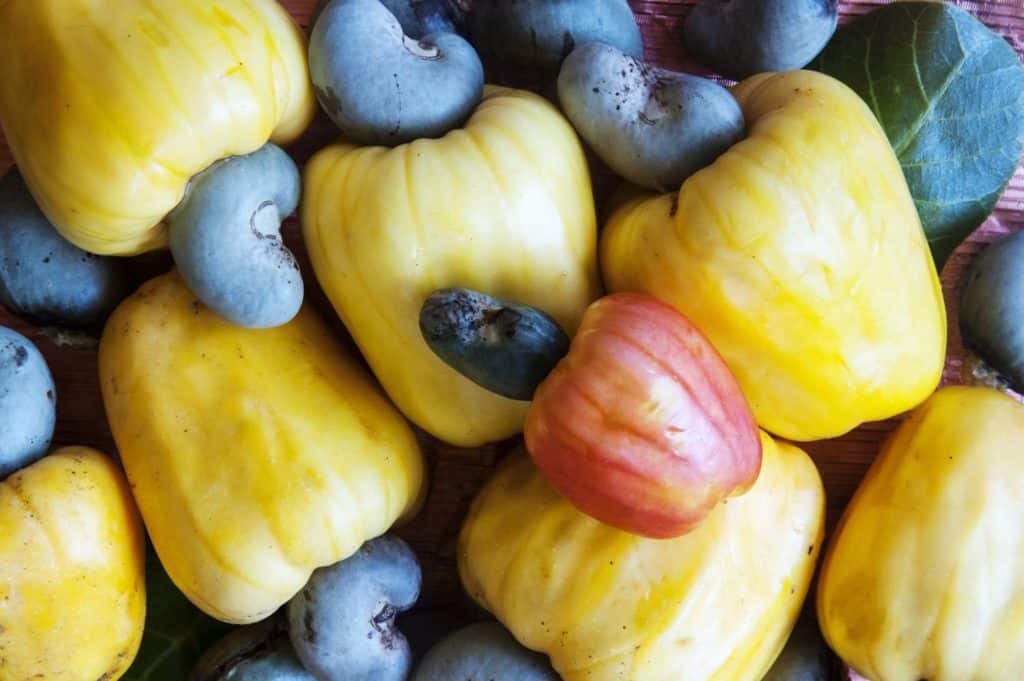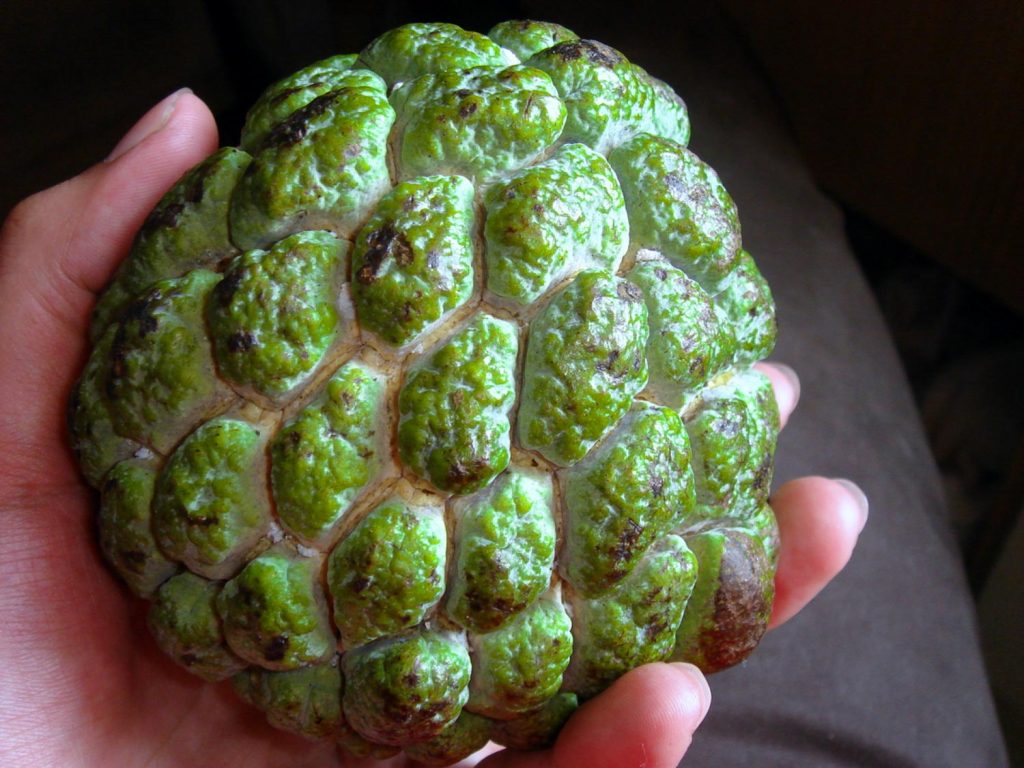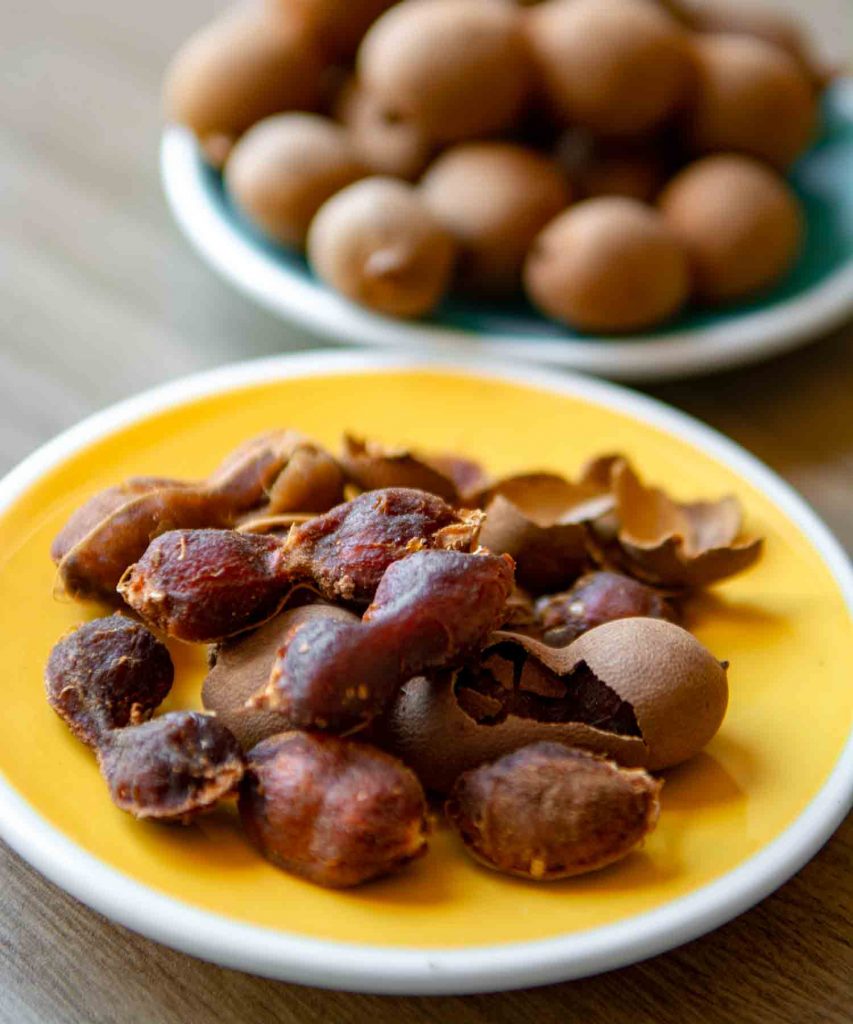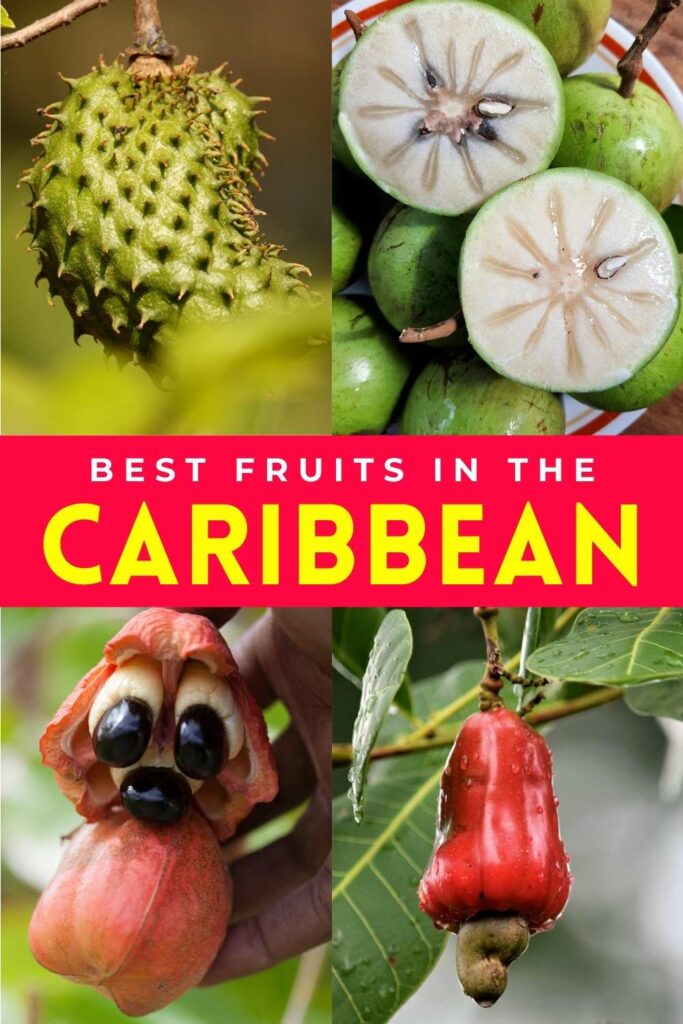The Caribbean isn’t just turquoise waters and soft sand, tropical Caribbean fruits are the bucket list you need to explore.
I’m obsessed with discovering new fruits wherever I travel, and the Caribbean has become one of my favorite hunting grounds.
Every time I visit I am prepared with a list of exotic fruits in season, and hoping I can still find a few that may not be as common. It’s actually a great way to meet local friends as I want to explore something so simple it’s a great conversation starter.
The Caribbean’s unique mix of African, Indigenous and colonial influences has created an incredible fruit diversity that you won’t find anywhere else.
Some of these fruits were brought by enslaved Africans who carried seeds in their hair. Others arrived with European colonizers looking for new cash crops.
Many have been growing in Caribbean soil for so long they’ve become as much a part of island culture as steel drums and carnival.
Below are the most interesting and unusual fruits I’ve discovered across the Caribbean islands. There’s more to the region than its incredible Caribbean beaches. I’ve included scientific names because many of these fruits go by different names on different islands, and I want you to know exactly what to ask for.
Please keep in mind that traditional health benefits mentioned haven’t all been proven by modern science. This isn’t medical advice, just cultural knowledge passed down through generations.
Caribbean Fruits
1. Genipap | Jagua
Genipap might be the most unusual fruit you’ll encounter in the Caribbean because it’s not just food, it’s also body paint!
This brown, tomato-sized fruit has been used by Indigenous Caribbean peoples for centuries. The unripe fruit produces a blue-black dye that was traditionally used for body painting and still is today for cultural ceremonies.
When ripe, the fruit is edible but quite astringent. The flesh is brownish and has an acquired taste that’s both sweet and bitter. Most people prefer it processed into jam or fermented drinks rather than eating fresh.
Although not well known it actually is indigenous to a wide span of the Americas. It is a native Brazilian fruit from the Amazon and grows all the way through Central America.
The tree grows wild throughout many Caribbean islands, and you’ll often see children with blue-black stains on their hands from playing with the unripe fruits.
It’s rich in tannins and has been used traditionally for treating various ailments, though you’re more likely to encounter it as a natural dye than as food.
Scientific Name: Genipa americana
Common Name in other Countries: Jagua, huito
Genipap Season: June to September
Common in these Countries: Trinidad and Tobago, Guyana, Suriname, Venezuela, French Guiana
Fruit in Trinidad and Tobago
2. Breadnut | Capomo | Chataigne
Often confused with breadfruit, breadnut is actually quite different and much more nutritious.
This large, spiky fruit can weigh up to 10 pounds and is covered in soft spines. Unlike breadfruit, breadnut has large seeds inside that are the real treasure. These seeds taste like chestnuts when roasted and were a crucial protein source for pre-Columbian Caribbean peoples.
The flesh around the seeds is also edible but starchy and bland. It’s the seeds that make this fruit special, providing protein, healthy fats and minerals that were essential for island survival.
You’ll need to cook breadnut before eating. Both the flesh and seeds require boiling or roasting. The seeds can be ground into flour or eaten whole like nuts.
Native to the Caribbean and Central America, breadnut trees can live for centuries and were considered sacred by some Indigenous groups.
Scientific Name: Artocarpus camansi
Common Name in other Countries: Seeded breadfruit, kamansi
Breadnut Season: July to November
Common in these Countries: Jamaica, Puerto Rico, Dominican Republic, Haiti, Trinidad and Tobago
3. Governor’s Plum | Batoko Plum
This small, dark purple fruit has a royal name but humble origins growing wild throughout the Caribbean.
Governor’s plum is about the size of a large grape with thin skin and soft, juicy flesh. The flavor is intensely tart, almost mouth-puckeringly sour, which is why it’s rarely eaten fresh.
Instead, it’s highly prized for making preserves, jams and traditional Caribbean drinks. The tartness makes it perfect for balancing sweet preparations, and many islanders consider it essential for proper rum punch.
The trees are hardy and drought-resistant, often growing wild along roadsides and in abandoned lots. During fruit season, you’ll see children climbing these trees despite the sour reward.
It’s packed with vitamin C and antioxidants, making it a nutritional powerhouse despite its challenging flavor.
Scientific Name: Flacourtia indica
Common Name in other Countries: Madagascar plum, ramontchi
Governor’s Plum Season: April to July
Common in these Countries: Jamaica, Barbados, Trinidad and Tobago, Grenada
4. Mammee Apple | Tropical Giant
Don’t expect this to taste like an apple! Mammee apple is a massive fruit that can weigh up to 8 pounds and has creamy, orange flesh that tastes completely different from its name.
The fruit has thick, brown skin that must be peeled away to reveal bright orange flesh underneath. The flavor is sweet and aromatic, often compared to apricot mixed with peach, with a creamy texture that’s almost custard-like.
Native to the Caribbean, mammee apple trees are enormous and can produce fruit for over 100 years. The fruit takes almost a year to ripen from flower to harvest.
Inside you’ll find 1-4 large seeds surrounded by delicious flesh. The flesh can be eaten fresh, made into preserves or used in desserts. Some people make wine from fermented mammee apple.
The seeds and bark have been used traditionally for various medicinal purposes, though you should stick to the delicious flesh.
Scientific Name: Mammea americana
Common Name in other Countries: Mammey, mamey amarillo, Santo Domingo apricot
Mammee Apple Season: May to August
Common in these Countries: Jamaica, Cuba, Haiti, Dominican Republic, Puerto Rico, Trinidad and Tobago

5. Otaheite Apple | Mountain Apple
I first discovered this Caribbean fruit in Jamaica and I am so surprised it’s not more popular.
This bell-shaped fruit with waxy skin is refreshingly crisp and mildly sweet, perfect for the Caribbean heat.
Otaheite apple has thin, edible skin that ranges from pink to deep red. Inside is white, crunchy flesh that’s incredibly juicy with a subtle, sweet flavor. The texture is similar to a very crisp pear but with less sugar.
Originally from Pacific islands (hence the name Otaheite, an old name for Tahiti), it was brought to the Caribbean in the 18th century and has thrived in the tropical climate.
The fruit is mostly water, making it incredibly refreshing. It’s often eaten fresh as a thirst-quencher or added to fruit salads for its crisp texture and mild flavor.
Trees produce abundant fruit and are commonly planted in yards throughout the Caribbean. Children love climbing these trees for the refreshing snack.
Scientific Name: Syzygium malaccense
Common Name in other Countries: Mountain apple, Malay apple, pomarrosa
Otaheite Apple Season: April to September
Common in these Countries: Jamaica, Trinidad and Tobago, Puerto Rico, Dominican Republic, Grenada, St. Lucia
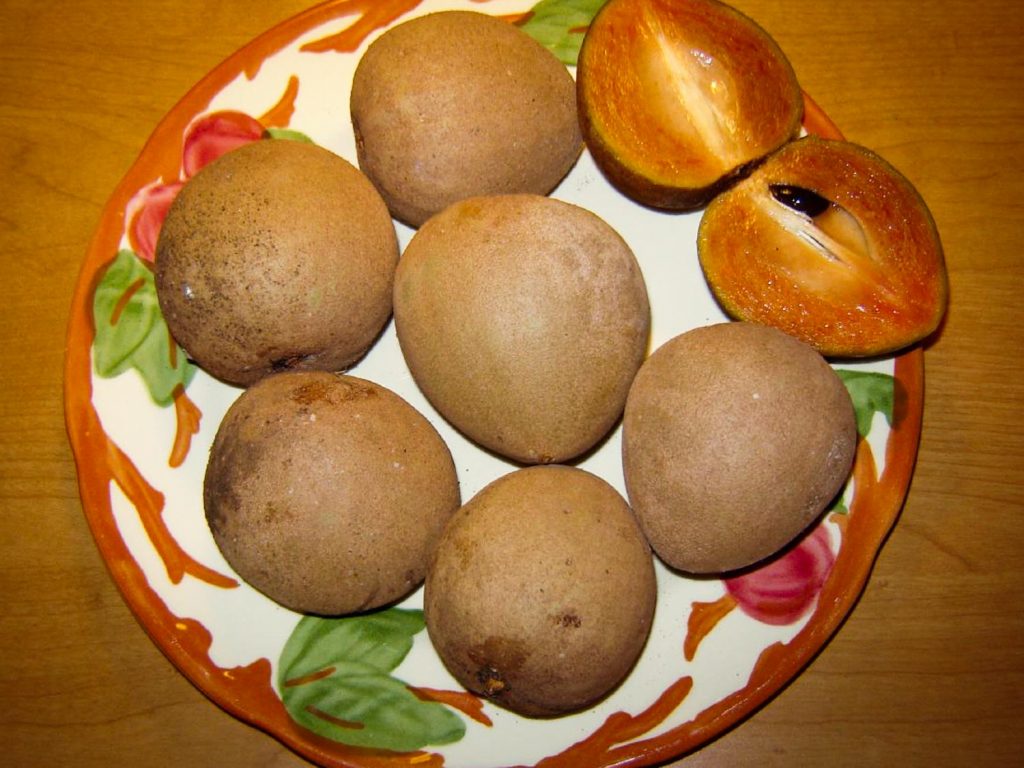
6. Naseberry | Sapodilla
I first tried this fruit in Mexico, where it is native along with the Caribbean. I was perplexed by the flavor and the texture as this isn’t what I knew a fruit to be.
It’s about the size of a large kiwi and has a grainy texture with a taste I can only explain as an apple pie with spices.
The flavor is incredibly sweet, often described as brown sugar mixed with pear.
The tree that produces naseberry is the source of natural chicle, the original base for chewing gum. Maya peoples chewed the tree’s sap long before modern gum was invented.
When perfectly ripe, naseberry is one of the sweetest fruits you’ll ever taste. Unripe fruit is astringent and unpleasant, so timing is everything. Look for fruits that yield slightly to pressure.
The seeds are large and shiny black, inedible but often saved by children for games.
Scientific Name: Manilkara zapota
Common Name in other Countries: Sapodilla, chiku, chicle, chicozapote
Naseberry Season: December to May
Common in these Countries: Jamaica, Belize, Guatemala, Trinidad and Tobago, Barbados
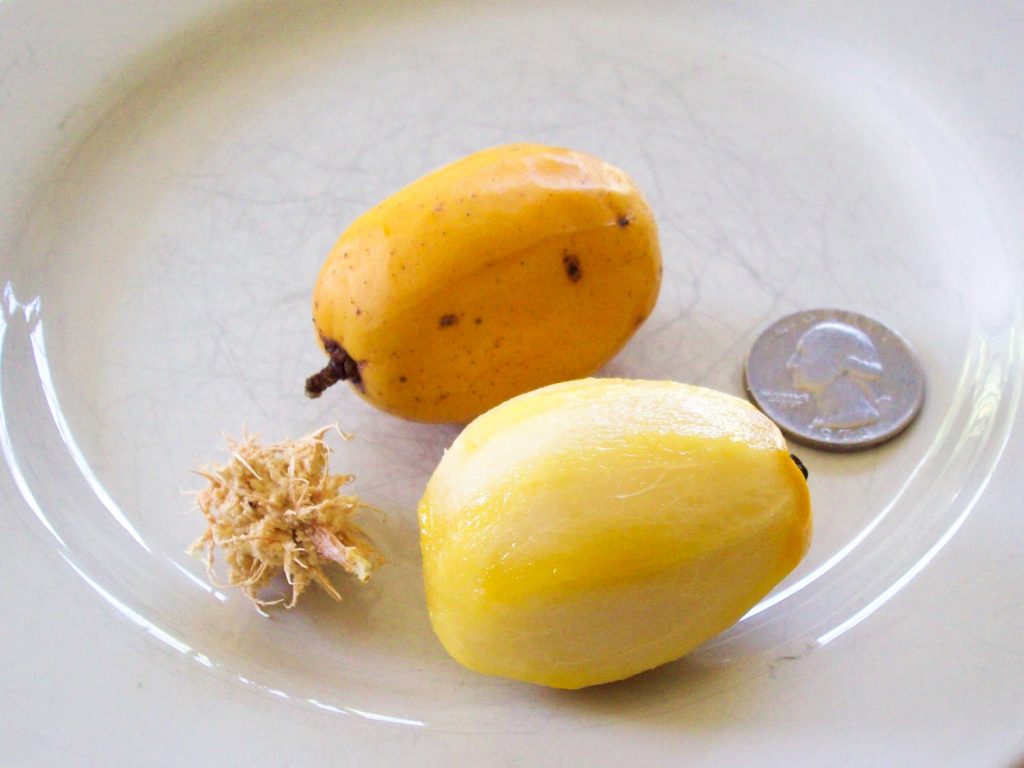
7. Golden Apple | June Plum
This oval, golden fruit is crunchy like an apple but with tropical flavors that scream Caribbean sunshine.
Golden apple has smooth, golden-yellow skin when ripe. The flesh is white, crisp and very juicy with a flavor that’s tart when young and sweet-tart when fully ripe. The texture remains crunchy even when ripe.
Originally from Polynesia, it was brought to the Caribbean by Captain Bligh (yes, the same guy from the mutiny) in the late 1700s. It quickly became popular throughout the islands.
The fruit is excellent eaten fresh, especially with salt and pepper, which is a popular Caribbean preparation. It’s also pickled, made into preserves or used in chutneys.
Both ripe and unripe fruit are edible, offering different flavor profiles. Unripe fruit is more sour and often preferred for savory preparations.
Scientific Name: Spondias dulcis
Common Name in other Countries: Ambarella, hog plum, vi-apple
Golden Apple Season: August to February
Common in these Countries: Jamaica, Trinidad and Tobago, Barbados, Grenada, St. Vincent and the Grenadines
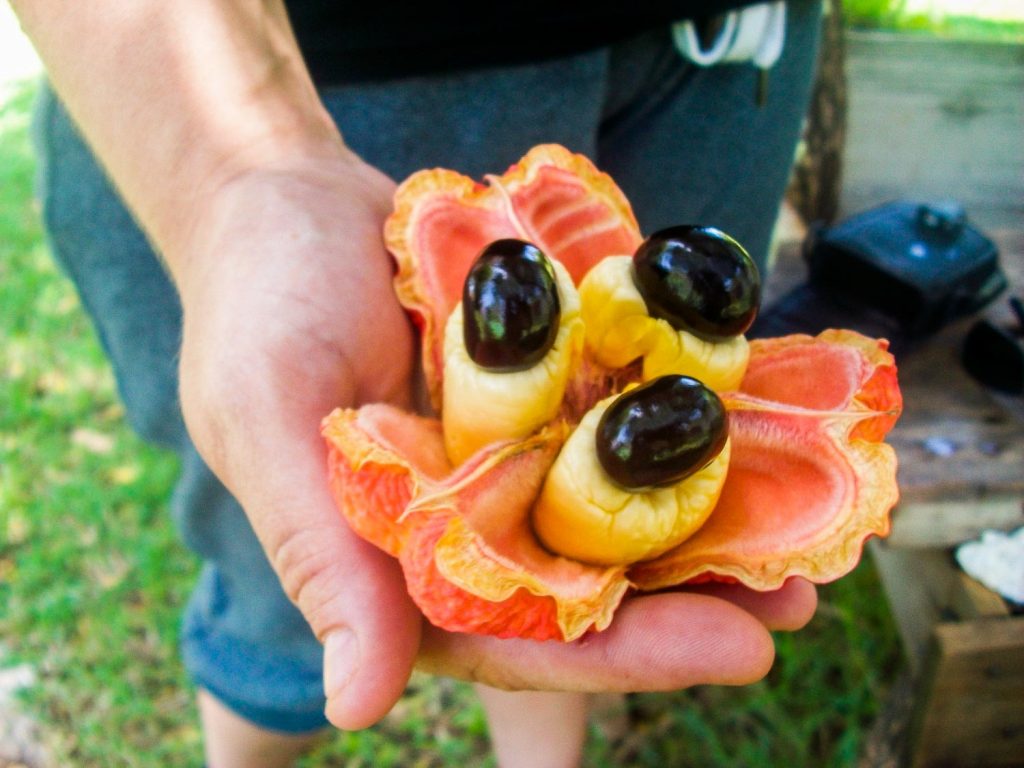
8. Ackee
Jamaica’s national fruit is also one of the most dangerous if not prepared properly, making it the most infamous fruit in the Caribbean.
Ackee grows in bright red pods that split open when ripe to reveal three shiny black seeds, each topped with creamy yellow flesh. Only the yellow flesh is edible and only when the pod has opened naturally.
The flavor is subtle and creamy, often compared to scrambled eggs, which is why it pairs perfectly with saltfish in Jamaica’s national dish.
Originally from West Africa, ackee was brought to the Caribbean by enslaved peoples and became deeply integrated into Jamaican culture.
The fruit can be found in tropical areas like Haiti, Cuba, Bahamas, Costa Rica, Panama and Brazil, though Jamaica remains its spiritual home.
But to be honest I have never see this fruit in Cuba. I lived in Havana for two years but I also did not see it in the east, which has more Afro-Cuban cuisine. So it may exist but I don’t think it’s common.
Unripe ackee contains toxins that can be fatal, so it must be allowed to open naturally before harvesting. This makes it one of the few fruits that can kill you if eaten incorrectly.
Scientific Name: Blighia sapida
Common Name in other Countries: Vegetable brain
Ackee Season: January to March and June to August
Common in these Countries: Jamaica, Haiti, Bahamas
9. Cashew Apple
Here’s something that’ll blow your mind: the cashew nut you know grows attached to a juicy, bell-shaped fruit!
I first saw this at a market in Brazil and was shocked, I guess because I had not thought much about cashews and assumed it was a regular nut.
The cashew apple is actually a swollen stem, not technically a fruit, but it’s juicy and edible with a sweet-tart flavor and astringent aftertaste. The familiar cashew nut hangs from the bottom.
While cashew nuts are exported globally, the “apple” is usually consumed locally because it’s highly perishable and the astringent compounds make your mouth feel dry and puckery.
In the Caribbean, cashew apples are often made into juice, wine or jam. The astringency can be reduced by removing the skin or processing the fruit.
The trees grow wild throughout many Caribbean islands, and during season you’ll find them loaded with the distinctive fruits topped by curved nuts.
Scientific Name: Anacardium occidentale
Common Name in other Countries: Caju, marañón, anacardo
Cashew Apple Season: March to July
Common in these Countries: Jamaica, Trinidad and Tobago, Barbados, Dominican Republic, Puerto Rico
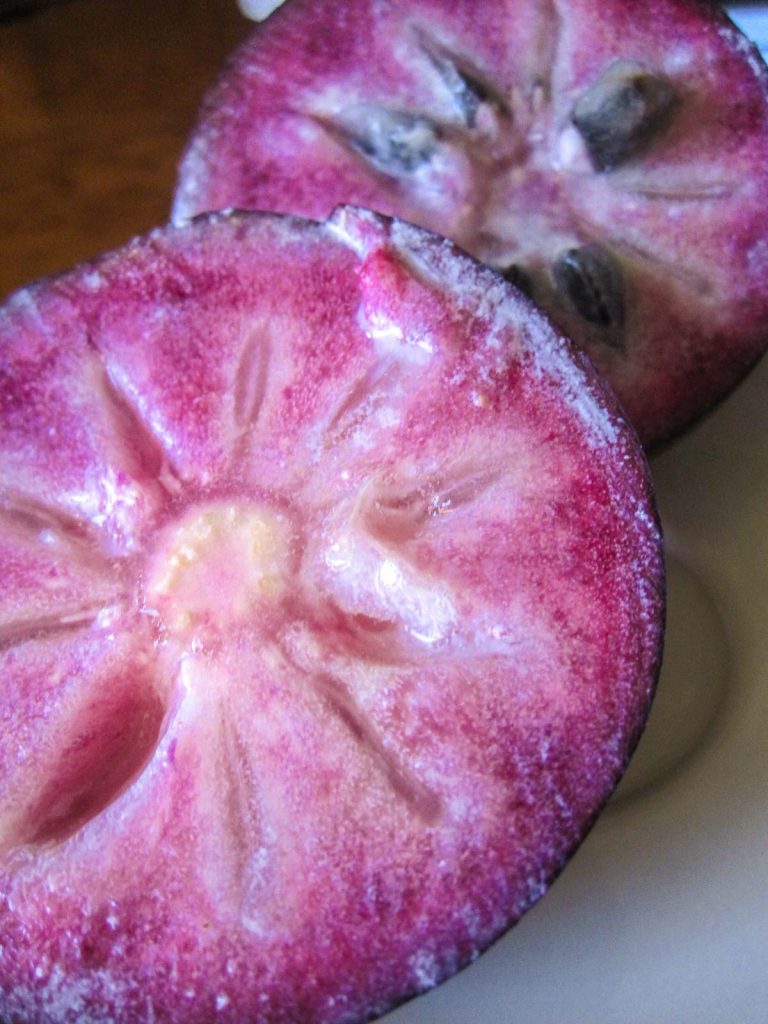
10. Star Apple
Cut this purple fruit in half and you’ll see why it’s called star apple, the seeds form a perfect star pattern that’s almost too beautiful to eat.
Star apple has thick, purple skin (sometimes green) that’s inedible. Inside is sweet, translucent flesh that’s incredibly juicy with a texture similar to persimmon. The flavor is mild and sweet with hints of grape.
Native to the West Indies and Central America, this fruit has been cultivated in Caribbean gardens for centuries. The trees are beautiful with glossy leaves that are golden on the underside.
The fruit is best eaten chilled and requires a specific technique. Cut it in half and scoop out the flesh with a spoon, avoiding the bitter skin and seeds.
The milky sap from the tree and unripe fruit can be sticky, so many people prefer to eat it with utensils rather than hands.
Scientific Name: Chrysophyllum cainito
Common Name in other Countries: Caimito, estrella, aguay
Star Apple Season: February to June
Common in these Countries: Jamaica, Cuba, Haiti, Dominican Republic, Puerto Rico, Trinidad and Tobago
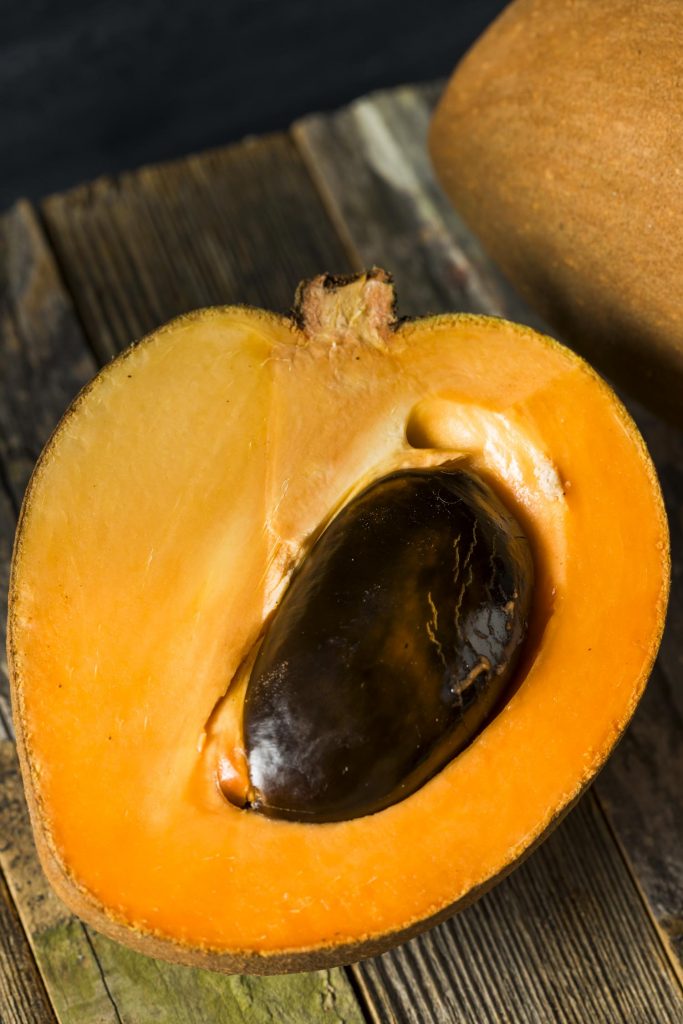
11. Mamey Sapote
This football-sized fruit with rough brown skin hides some of the most delicious flesh in the Caribbean.
Mamey sapote has thick, sandpaper-like skin that must be peeled to reveal bright orange flesh inside. The flavor is rich and sweet, like a combination of sweet potato, pumpkin pie and honey.
The texture is creamy and smooth, almost custard-like, making it perfect for milkshakes, ice cream and desserts. In Cuba, mamey milkshakes are legendary.
Native to southern Mexico and Central America, it spread throughout the Caribbean where it became prized for its rich flavor and nutritional value. The fruit is packed with beta-carotene, giving it that gorgeous orange color.
Inside you’ll find 1-3 large, shiny brown seeds that aren’t edible. The flesh around the seeds is the treasure, with a flavor so rich it almost tastes like dessert.
Scientific Name: Pouteria sapota
Common Name in other Countries: Zapote colorado, red mamey
Mamey Sapote Season: May to September
Common in these Countries: Cuba, Dominican Republic, Haiti, Jamaica, Puerto Rico
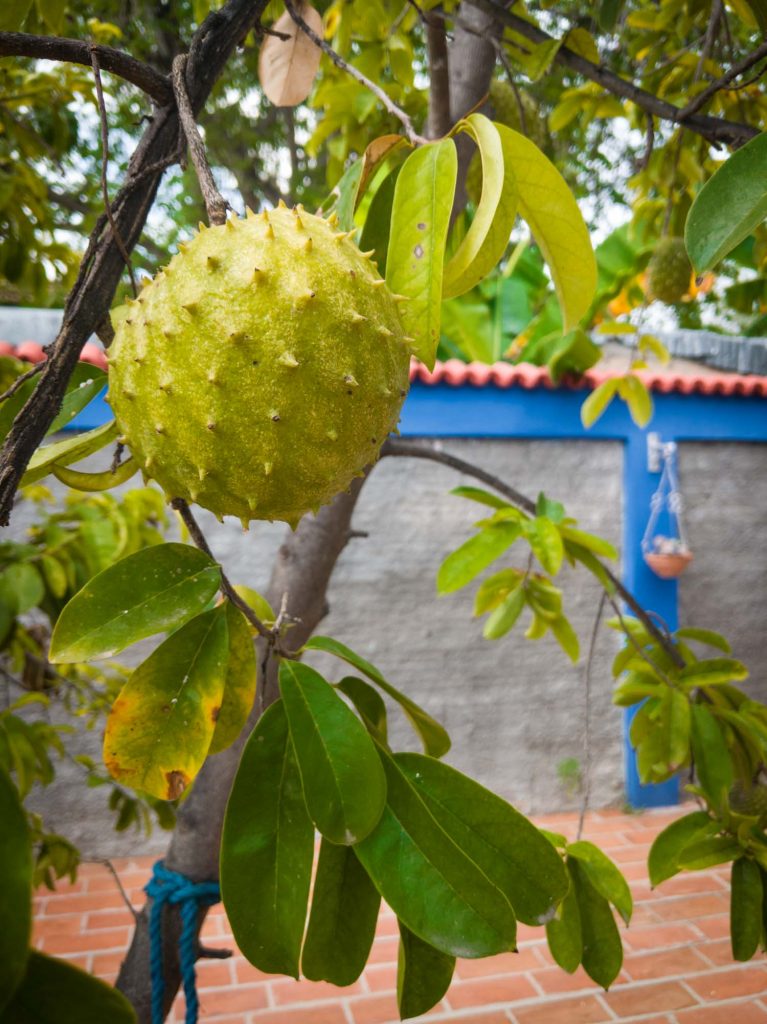
12. Soursop
This large, spiky green fruit contains some of the most unusual and delicious flesh you’ll find in the Caribbean.
I discovered it first as a South American fruit, where it is known as guanabana. And it quickly became one of my favorites.
Soursop can grow quite large, sometimes weighing several pounds, and is covered in soft spines. Inside is white, cotton-like flesh with large black seeds scattered throughout.
The flavor is complex and tropical, like a combination of strawberry, pineapple and citrus with a creamy texture. It’s tart and sweet simultaneously, with an almost effervescent quality.
Native to the Caribbean and Central America, soursop is highly valued both for its delicious flavor and traditional medicinal uses. The flesh is incredibly refreshing and perfect for smoothies.
The seeds aren’t edible, so you eat around them or strain the pulp for juices. The flesh is soft and easily scooped out with a spoon.
Scientific Name: Annona muricata
Common Name in other Countries: Graviola, guanabana, Brazilian pawpaw
Soursop Season: June to September
Common in these Countries: Jamaica, Trinidad and Tobago, Barbados, Cuba, Haiti, Dominican Republic, Puerto Rico
13. Sweetsop
The cousin of soursop, sweetsop is smaller and sweeter with a completely different texture and appearance.
Sweetsop has bumpy, light green skin that’s easy to pull apart when ripe. Inside are segments of sweet, creamy white flesh surrounding shiny black seeds. Each segment can be popped in your mouth and eaten around the seed.
The flavor is incredibly sweet and creamy, often compared to custard or vanilla ice cream. It’s much sweeter than soursop with less tartness. It makes for an amazing smoothie.
Native to the Caribbean and Central America, sweetsop has been cultivated for centuries. The trees are smaller than soursop and the fruits ripen faster.
The texture is grainier than soursop but equally delicious. When perfectly ripe, the skin practically falls off and the flesh is soft and sweet.
Scientific Name: Annona squamosa
Common Name in other Countries: Sugar apple, custard apple, ata
Sweetsop Season: August to November
Common in these Countries: Jamaica, Cuba, Haiti, Dominican Republic, Puerto Rico, Trinidad and Tobago
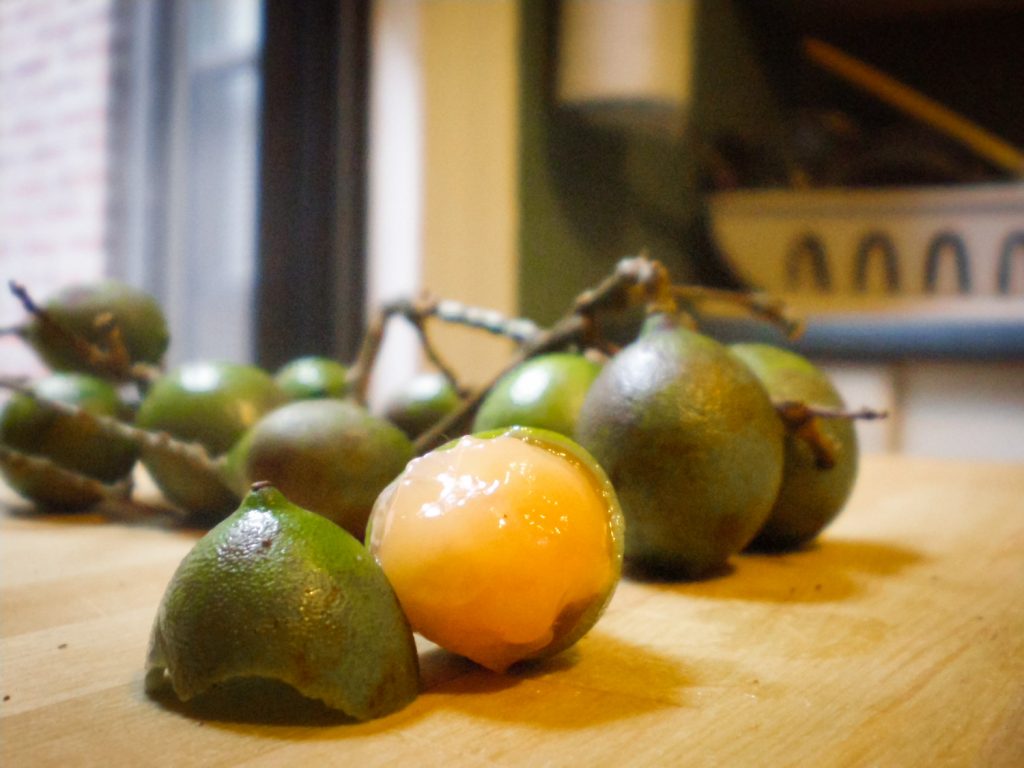
14. Guinep | Spanish Lime
These small, green fruits grow in clusters and have become almost synonymous with Caribbean childhood memories.
Guinep are small, round fruits that grow on trees native to the New World tropics including the Caribbean. The skin is thin and green, easily removed by biting and peeling.
Inside is a large seed surrounded by translucent, orange flesh that’s sweet and tangy with a texture similar to lychee. The taste can be compared to a lychee fruit balanced with a sweet lime.
Known by many names including genip, Spanish lime, mamoncillo and quenepa, the tree is originally from the Orinoco basin. In different Caribbean countries, you’ll hear different names for the same fruit.
They’re typically sold in clusters and eaten as snacks. Children love them despite the large seed that takes up most of the space. The flesh clings to the seed, so you suck it off and spit out the seed.
It’s also a common Colombian fruit called mamoncillo.
Scientific Name: Melicoccus bijugatus
Common Name in other Countries: Quenepa, kenep, Spanish lime, mamoncillo
Guinep Season: June to September
Common in these Countries: Jamaica, Trinidad and Tobago, Barbados, Puerto Rico, Dominican Republic, Haiti
15. Tamarind
These brown, pod-like fruits contain sticky pulp that’s essential to Caribbean cuisine and beloved as a snack.
Tamarind pods are brown and curved, containing seeds surrounded by sticky, brown pulp. The flavor is intensely sour when young, becoming sweet-sour as it ages.
Originally from Africa, tamarind was brought to the Caribbean early in colonial times and has become integral to island cooking. It’s used in sauces, drinks, candies and eaten fresh.
The pulp is incredibly tangy and flavorful, used to add sourness to dishes or enjoyed as a tart snack. Many Caribbean people have childhood memories of eating tamarind straight from the pod.
You crack open the brittle shell to access the pulp inside. The pulp clings to the seeds, so you either suck it off or use it in cooking where the seeds can be removed.
Scientific Name: Tamarindus indica
Common Name in other Countries: Tamarin, sampalok,
Tamarind Season: December to May
Common in these Countries: Jamaica, Trinidad and Tobago, Barbados, Cuba, Haiti, Dominican Republic, Puerto Rico
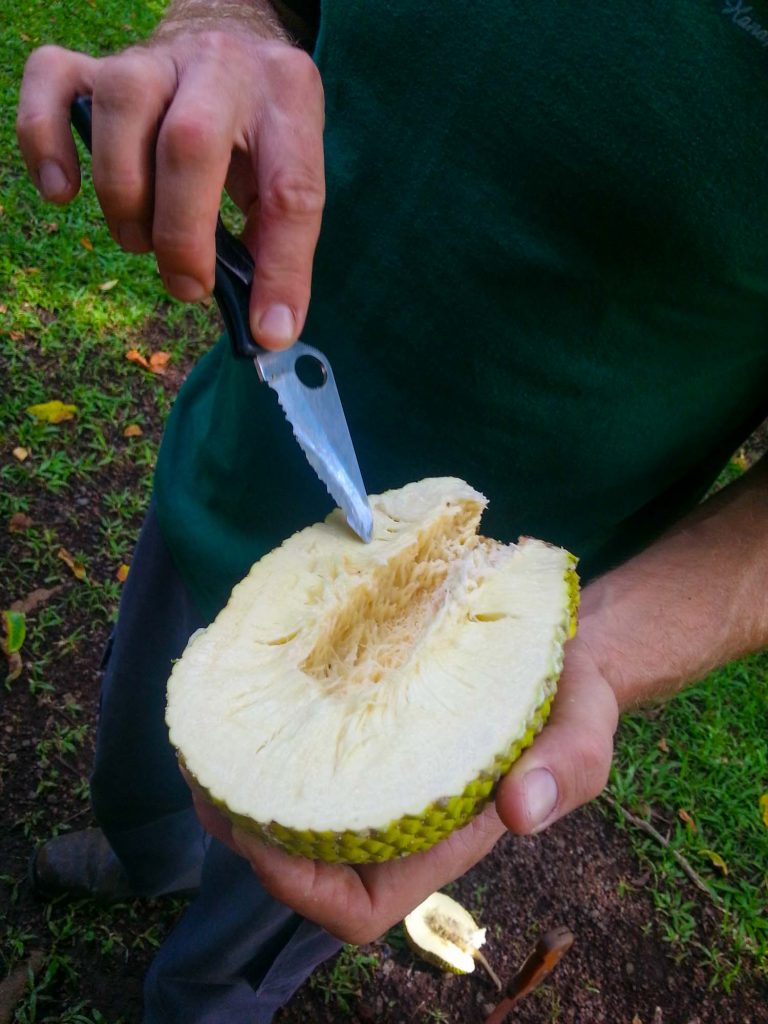
16. Breadfruit
This large, round fruit became a Caribbean staple thanks to Captain Bligh’s famous voyage and has fed island populations for centuries.
Breadfruit is large and round with bumpy, green skin. Inside is starchy, white flesh that tastes similar to potato when cooked. It must be cooked before eating and is never consumed raw.
Originally from the Pacific Islands, breadfruit was brought to the Caribbean in the late 1700s as cheap food for enslaved populations. It quickly became a dietary staple throughout the islands.
Today it is hailed as a superfood as it grows well in tropical areas. I visited the Breadfruit Institute in Hawaii where it is known as ulu, they are preserving over 120 varieties.
The fruit is incredibly versatile and can be boiled, roasted, fried or baked. When cooked, it has a mild, slightly sweet flavor and bread-like texture that’s filling and nutritious.
When it’s overripe it’s like a custard.
Breadfruit trees are productive and can feed families year-round. A single tree can produce 200-300 fruits annually for decades.
Scientific Name: Artocarpus altilis
Common Name in other Countries: Ulu, panapen, fruta de pan
Breadfruit Season: July to February
Common in these Countries: Jamaica, Trinidad and Tobago, Barbados, St. Lucia, Grenada, Dominica, Haiti, Dominican Republic
17. Carambola | Star Fruit
When sliced, this yellow fruit creates perfect five-pointed stars, making it one of the most photogenic fruits in the Caribbean.
Carambola has waxy, yellow skin that’s completely edible along with the crisp, juicy flesh inside. The flavor ranges from tart when unripe to sweet-tart when fully yellow and ripe.
Originally from Southeast Asia, carambola was brought to the Caribbean centuries ago and now grows throughout the region. The trees are prolific producers and fruit almost year-round.
The entire fruit is edible, making it convenient for snacking. The flavor is refreshing and citrusy, with a texture similar to a crisp apple or pear.
It’s high in vitamin C and makes beautiful garnishes for drinks and desserts. The natural star shape makes it perfect for tropical fruit salads and presentations.
Scientific Name: Averrhoa carambola
Common Name in other Countries: Star fruit, five-finger
Carambola Season: Year-round
Common in these Countries: Jamaica, Trinidad and Tobago, Puerto Rico, Dominican Republic, Haiti, Barbados
